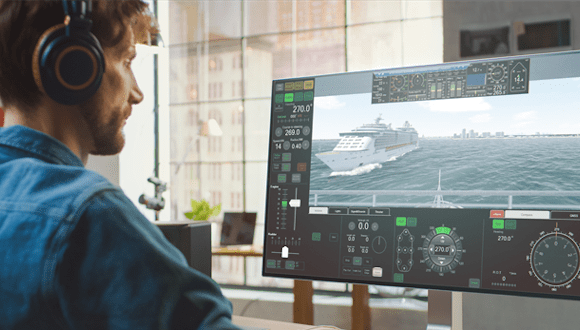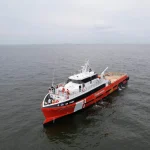Acoustic Monitoring: An Innovative Approach to Studying Marine Life

The oceans of our planet have captivated human interest for centuries. Yet, despite our fascination, the depths of the ocean remain largely unexplored. However, recent technological advancements in the field of acoustic monitoring have opened up new avenues of research into the underwater world. Acoustic monitoring uses underwater sound to study marine animals, such as whales and dolphins, and measure oceanographic features. In this post, we will explore the exciting field of acoustic monitoring, its applications, and its potential for revolutionizing our understanding of marine life.
What is Acoustic Monitoring?
Acoustic monitoring involves the use of hydrophones, which are underwater microphones, to record the sounds made by marine animals and measure oceanographic features such as temperature, salinity, and water currents. Hydrophones can be deployed on the seafloor, on buoys, or even attached to animals themselves to collect data. The recorded sounds can then be analysed to identify the species, track their movements, and gain insights into their behaviour.
Acoustic Monitoring and Marine Mammals
One of the most important applications of acoustic monitoring is in the study of marine mammals, such as whales and dolphins. These animals rely heavily on sound to communicate, navigate, and locate food in their underwater environment. By recording their vocalizations, scientists can identify different species and even individual animals, track their movements, and study their behaviour.
For example, acoustic monitoring has been used to study the vocalizations of humpback whales, which are known for their complex songs. By analysing the patterns and rhythms of their songs, researchers can gain insights into their social behaviour and even identify individual whales based on their unique vocalizations.
Acoustic Monitoring and Oceanography
Acoustic monitoring is not limited to the study of marine mammals, however. It can also be used to measure various oceanographic features – temperature, salinity, and water currents. By deploying hydrophones at different depths, scientists can track the movement of water masses and gain insights into ocean circulation patterns.
One example of this is the study of the Antarctic Circumpolar Current (ACC), which is the largest ocean current on Earth. The ACC plays a crucial role in global ocean circulation and climate regulation. However, measuring the current is challenging due to the remote location and harsh conditions of the Southern Ocean. Acoustic monitoring provides a valuable tool for studying the ACC, as it can track the movement of water masses and measure the speed and direction of the current.
Challenges and Limitations of Acoustic Monitoring
While acoustic monitoring is a powerful tool for studying marine life and oceanography, it is not without its challenges and limitations. One of the main challenges is the background noise in the ocean, which can interfere with the recording of animal vocalizations and other sounds of interest. This noise can come from a variety of sources, such as ships, seismic surveys, and natural phenomena like waves and storms.
To address this challenge, scientists use advanced signal processing techniques to filter out the unwanted noise and extract the desired signals. They also carefully select the locations and times of deployment to minimise the impact of background noise.
Another challenge of acoustic monitoring is the cost and logistical challenges of deploying and maintaining hydrophones in remote locations. This can involve long research cruises, complex equipment, and skilled personnel to operate and maintain the instruments.
Conclusion
Acoustic monitoring is a rapidly evolving field that has the potential to revolutionise our understanding of the underwater world. By using sound to study marine life and oceanography, scientists can gain insights into the behaviour of marine animals, track their movements, and measure important oceanographic features. While there are challenges and limitations to this approach, advances in technology and signal processing techniques continue to improve our ability to collect and interpret acoustic data. As we learn more about the underwater environment, we can provide better protection for the ocean resources, which are crucial for the overall health of our planet and the well-being of millions of people who depend on them for food, livelihoods, and recreation.
One of the most exciting aspects of acoustic monitoring is its potential for uncovering new species and behaviours that were previously unknown. For example, in recent years, acoustic monitoring has revealed the existence of a new species of beaked whale, which was previously unrecognised. This discovery highlights the importance of continued research and exploration of our oceans and the potential for acoustic monitoring to reveal new insights into the mysteries of the deep.
In addition to scientific research, acoustic monitoring has practical applications in industries such as oil and gas exploration, fisheries management, and naval defence. For example, acoustic monitoring can help reduce the impact of seismic surveys on marine mammals by providing information on their distribution and behaviour, and help prevent collisions between ships and whales by detecting their presence in the vicinity of shipping lanes.
As the field of acoustic monitoring continues to evolve, it will require interdisciplinary collaboration between scientists, engineers, and stakeholders from various sectors. By working together, we can develop innovative technologies and methods for studying the underwater environment and better understand its complex ecological and physical processes.
In conclusion, acoustic monitoring is a powerful tool for studying marine life and oceanography, offering valuable insights into the traits of marine animals and the physical processes that shape our oceans. While there are challenges and limitations to this approach, continued advancements in technology and signal processing techniques offer exciting opportunities for further exploration and discovery in the underwater world. As we learn more about our oceans, we can better protect and conserve these vital resources for future generations.
Resources
Acoustic Monitoring For Conservation and Ecological Research
The role of oceanography and ocean physics in marine ecology















